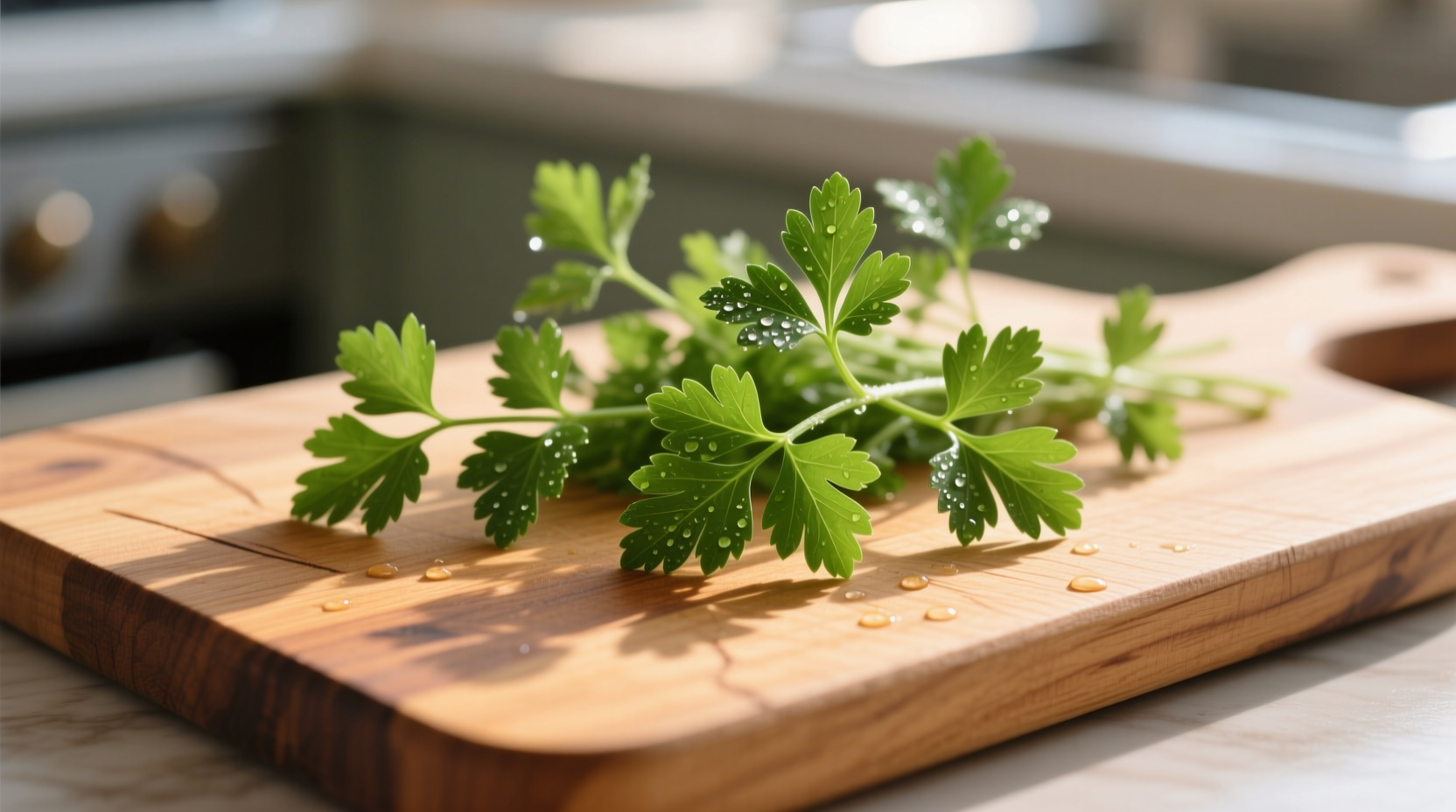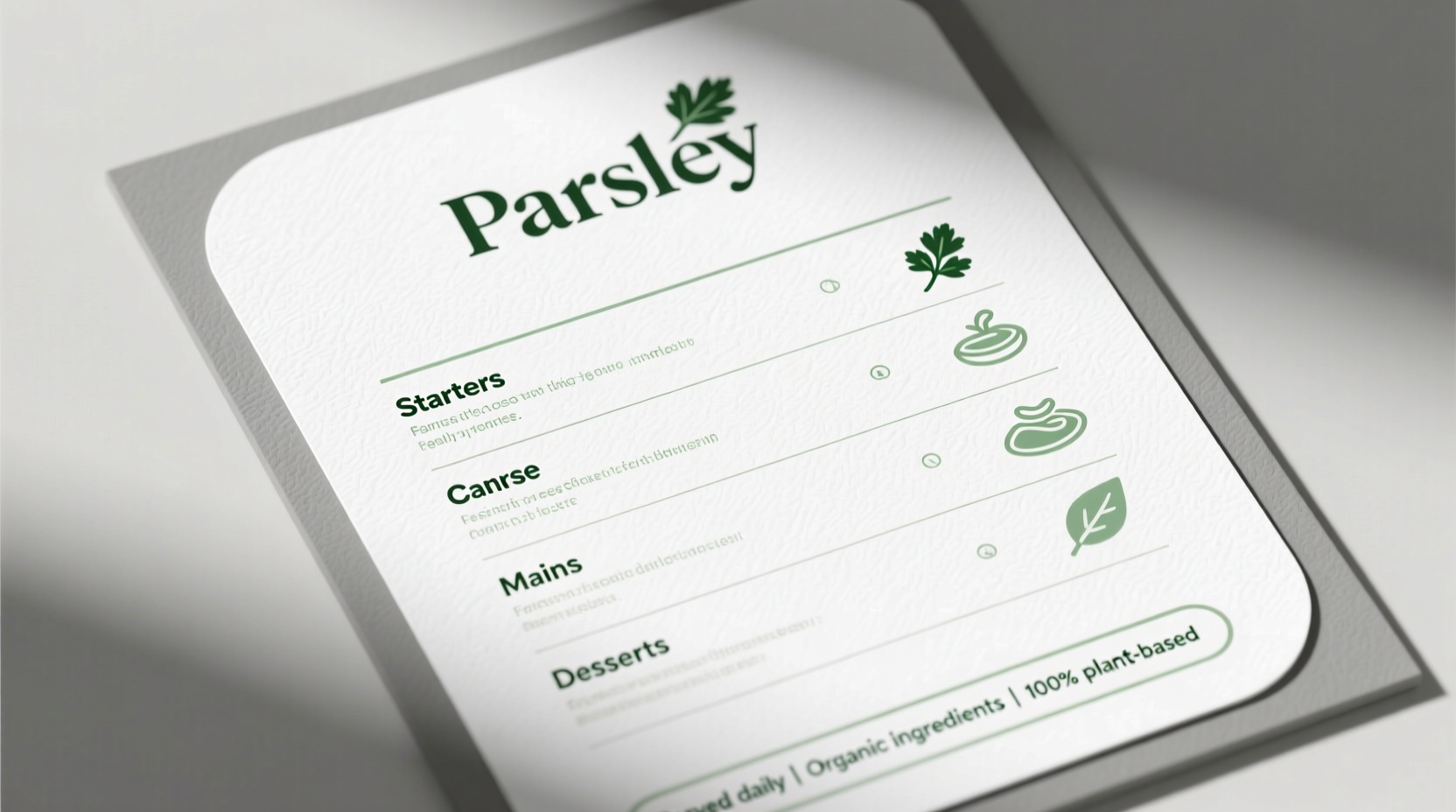Most home cooks relegate parsley to the role of mere garnish, but this versatile herb deserves center stage in your culinary repertoire. Understanding how to build a thoughtful parsley menu elevates everyday meals while maximizing the herb's distinctive flavor profile and impressive nutritional benefits. This guide reveals practical strategies for incorporating parsley as a main ingredient across multiple courses, transforming your approach to meal planning.
Why Parsley Deserves Menu Spotlight
Parsley's culinary significance extends far beyond its decorative role. With nearly 800% of your daily vitamin K in just one cup (USDA FoodData Central), plus substantial vitamin C and iron, this humble herb delivers remarkable nutritional density. Unlike many herbs that lose potency when cooked, parsley maintains its bright flavor profile through various preparation methods, making it uniquely versatile for comprehensive menu planning.
| Parsley Variety | Flavor Profile | Best Menu Applications | Seasonal Availability |
|---|---|---|---|
| Flat-leaf (Italian) | Bold, peppery, robust | Main courses, sauces, marinades | Spring through fall |
| Curly parsley | Milder, slightly bitter | Garnishes, salads, finishing touches | Year-round |
| Japanese parsley | Distinctive citrus notes | Asian-inspired dishes, dressings | Limited seasonal availability |
The Evolution of Parsley in Culinary Traditions
Understanding parsley's historical journey reveals why it deserves prominent menu placement. Originally cultivated in the Mediterranean region, parsley evolved from medicinal herb to culinary staple through distinct phases:
- Ancient Greece (500 BCE): Used primarily for medicinal purposes and ceremonial wreaths
- Roman Empire: Incorporated into cooking as both flavoring and digestive aid
- Medieval Europe: Featured prominently in "pot herbs" for stews and broths
- Renaissance Period: Became essential in French and Italian culinary traditions
- Modern Era: Recognized for both culinary versatility and nutritional density
This historical progression demonstrates parsley's transition from peripheral herb to essential culinary component—a journey that informs contemporary approaches to parsley menu development.
Building Your Parsley-Centric Meal Framework
Creating a successful parsley menu requires strategic planning across multiple meal components. Start with these practical implementation steps:
- Assess freshness: Select bright green, crisp leaves without yellowing—this ensures maximum flavor impact
- Preparation technique: Chop just before use to preserve volatile oils that deliver distinctive flavor
- Temperature considerations: Add flat-leaf varieties early in cooking for infused flavor; curly varieties work best as finishing elements
- Flavor balancing: Pair with complementary ingredients like lemon, garlic, and olive oil to enhance parsley's natural profile
Professional chefs recommend dedicating 15-20% of your herb budget to parsley when developing a parsley-focused menu, recognizing its dual role as both flavor component and visual element.

Parsley Applications Across Menu Courses
Move beyond the garnish plate with these course-specific applications that showcase parsley's versatility:
Appetizers & Salads
Create vibrant parsley pesto by substituting half the basil with flat-leaf parsley, then blend with pine nuts, Parmesan, and quality olive oil. This variation maintains traditional pesto's creaminess while adding distinctive herbal notes. For salads, incorporate whole parsley leaves rather than chopped to maintain texture contrast.
Main Courses
Develop a parsley-forward sauce by simmering stems with aromatics, then blending with fresh leaves for a vibrant green accompaniment to fish or chicken. The James Beard Foundation notes that Mediterranean chefs traditionally use parsley stems in stocks to extract maximum flavor before employing leaves in finishing sauces.
Side Dishes
Transform standard side dishes by incorporating chopped parsley directly into preparations. Try adding generous amounts to roasted potatoes during the last five minutes of cooking, or mix into grain pilafs for added color and flavor complexity.
Contextual Considerations for Parsley Menus
While parsley offers remarkable versatility, certain contexts require careful consideration:
- Overpowering delicate flavors: Avoid prominent parsley use with subtle seafood like sole or flounder
- Dietary restrictions: Note that parsley contains significant vitamin K, which may concern those on blood thinners
- Seasonal limitations: Fresh parsley quality declines significantly in winter months unless greenhouse-grown
- Cultural expectations: In some traditional cuisines, parsley garnish carries specific meaning that shouldn't be altered
According to culinary research published in the Journal of Food Science, parsley's flavor compounds remain stable through various cooking methods, but prolonged high-heat exposure diminishes its distinctive volatile oils by up to 40%. This scientific insight informs optimal timing for parsley incorporation in menu development.
Common Parsley Menu Mistakes to Avoid
Even experienced cooks make these critical errors when developing parsley-focused menus:
- Using only the leaves while discarding nutrient-rich stems
- Adding parsley too early in the cooking process, diminishing flavor impact
- Mixing parsley varieties inconsistently throughout a single menu
- Over-chopping, which accelerates oxidation and flavor loss
- Storing improperly, reducing shelf life and flavor intensity
Professional kitchens address these issues through standardized preparation protocols that maximize parsley's contribution to menu items. Implement similar practices in your home kitchen by designating specific cutting techniques and timing protocols for parsley incorporation.
Seasonal Adaptation Strategies
Successful parsley menu planning requires seasonal awareness. During peak growing season (spring through early fall), fresh parsley delivers maximum flavor and nutritional benefits. In winter months, consider these adaptation strategies:
- Freeze chopped parsley in olive oil cubes for convenient cooking applications
- Use greenhouse-grown varieties that maintain better flavor profile
- Adjust quantities slightly upward to compensate for reduced flavor intensity
- Incorporate complementary herbs like chervil to maintain herbal complexity
These seasonal adjustments ensure your parsley menu maintains consistent quality year-round while respecting ingredient integrity.
What's the difference between using flat-leaf and curly parsley in menu planning?
Flat-leaf parsley offers a stronger, more robust flavor that holds up well during cooking, making it ideal for sauces, marinades, and main course components. Curly parsley has a milder flavor and maintains its visual appeal longer, working best as a finishing element or in raw applications. Professional chefs typically use flat-leaf for 80% of culinary applications where parsley serves as an ingredient rather than garnish.
How much parsley should I realistically incorporate into a single menu?
A balanced parsley menu typically features 1-2 cups of fresh parsley across multiple courses. Start with ¼ cup in appetizers, ½ cup in main courses, and ¼ cup in finishing touches. The key is strategic distribution rather than overwhelming quantities—parsley should enhance rather than dominate each dish. Remember that stems contain significant flavor and should be utilized in stocks and sauces.
Can I create a successful parsley menu with dried parsley?
Dried parsley lacks the vibrant flavor and visual appeal of fresh varieties and cannot effectively serve as the foundation for a dedicated parsley menu. Research from the Culinary Institute of America shows dried parsley retains less than 30% of the volatile compounds that give fresh parsley its distinctive flavor profile. For authentic parsley menu development, fresh is essential—consider freezing fresh parsley during peak season for winter use.
What are the nutritional benefits of featuring parsley prominently in a menu?
According to USDA FoodData Central, one cup of fresh parsley provides 800% of your daily vitamin K requirement, 133% of vitamin C, and significant amounts of vitamin A, iron, and folate. When incorporated across multiple menu courses, parsley significantly boosts the nutritional profile of your meal without adding calories. The vitamin C content also enhances iron absorption from plant-based foods, making it particularly valuable in vegetarian menu planning.
How do I prevent parsley from turning brown when incorporated into menus?
Prevent browning by minimizing exposure to air and heat. Chop parsley just before use, store stems in water like flowers, and add to dishes at the last possible moment. When preparing sauces, blanch parsley briefly in boiling water then shock in ice water to preserve vibrant color. Avoid acidic ingredients until serving time, as lemon juice and vinegar accelerate oxidation. Professional kitchens often use a small amount of baking soda in the blanching water to maintain green color.











 浙公网安备
33010002000092号
浙公网安备
33010002000092号 浙B2-20120091-4
浙B2-20120091-4